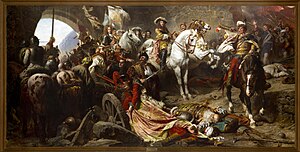Comăști Crusade
| Comăști Crusade | |||||||
|---|---|---|---|---|---|---|---|
| Part of Ethnic and Religious tensions within the Judeo-Dacian Empire | |||||||
 I'ir Duben Stands Strong, painting by Eli Rafi depicting the Third Battle of I'ir Duben, 1878. | |||||||
| |||||||
| Belligerents | |||||||
|
| ||||||
| Commanders and leaders | |||||||
| Strength | |||||||
|
| ||||||
| Casualties and losses | |||||||
| ~100,000 | ~300,000 | ||||||
|
~50,000 Civilians during the war ~250,000 Wallakhi civilians after the war | |||||||
The Comăști Crusade was one of four major ethno-religious conflicts within the Judeo-Dacian Empire during the late 1700's, as well as the longest. Starting after the First Comăști Incident, where the newly-coronated Emperor, Ezra Melekh IX, would be interperted as blaspheming against god in front of the Patrarch of the Dacian Orthodox Church, Rafael Dorin Vlad, who would proceed to rally the Christian population of the region to a Crusade against the Empire.
The Rally would be met with mixed adhearance, those who would listen would join either the Northern Dacian Legion , or the smaller Comăști Legion. While the rest would stay neutral, this however would change when in October of the same year, when the Wallakhi Recognition Council would be endorsed by the Patriarch, following an order to revoke the First Wallakhi Excommunication, while this move granted the Patriach's forces with a significant boost to it's soldier count, many of the remaining neutral Christians in the region would see this move as borderline heretical, as the Wallakhis were seen as pagans, despite being just a different christian scet, and hurried to join Imperial forces.
Meanwhile, The Judeo-Dacian Empire would negotiate with one of its former vassels, the Far-Duben Principality for help in the war effort, as it seemed that the combined Orthodox-Wallakhi legions would prove decisive for the Imperial forces to handle alone, resulting in the I'ir Duben Agreement, where the Far Duben Principality would be ceded some territory following the end of all hostilities within the empire in exchange for total war support, forcing the Orthodox-Wallakhi legions to split in a two-front war. Several years into the conflict, in 1784, another religious incident in the city of Comăști would occur, where the Wallakhians would attempt to coup d'etat the Dacian Orthodox Church, as they sought to negotiate their independence with the empire, as opposed to the Patriarch, who sought to unify it under one faith. The incident would see the death of Patriarch Rafael Dorin Vlad, and the seizure of power by the Wallakhis, who were supported by the Northern Dacian Legion, however, failure to kill the Patriarch's successor, Sandu Cosmin Vlad, caused the Second Wallakhi Excommunication and the exile of the church to Călănesea until the war's end, now siding with the Empire.
However the Wallakhians have misjudged the imperial position, now reinforced, the empire was helbent on re-establishing the national landscape, even at the cost of genociding entire demographics. And the rest of the war would be characterized by some of the most brutal battles of the four conflicts, and the end result would be even more brutal, a genocide which would see the total eradication of the Wallaki ethnicity and religion.
Contents
- 1 Background
- 2 Prelude
- 3 Course of the war
- 4 Aftermath
- 5 See Also
Background
Prelude
Course of the war
Initial Push
First Battle of Comăști
First Battle of Călănesea
First Battle of I'ir Duben
First Back and Forth
Second Battle of Comăști
Second Battle of I'ir Duben
I'ir Duben Agreement
First Wallakhi incursion into the Far-Duben
Second Comăști Incident
Second Back and Forth
Third Battle of Comăști
Third Battle of I'ir Duben
Second Wallakhi incursion into the Far-Duben
Third Back and Forth
Fourth Battle of I'ir Duben
Second Battle of Călănesea
Template:Battle of Călănesea (1786)